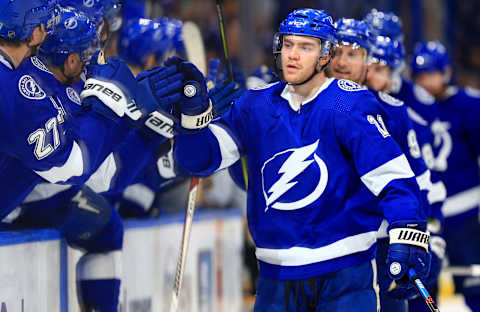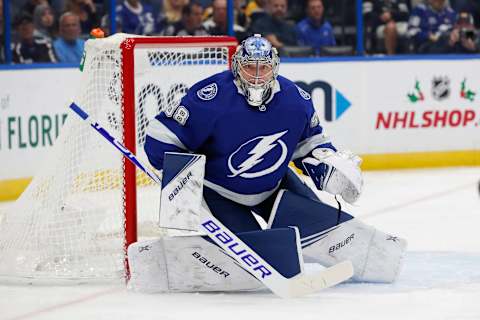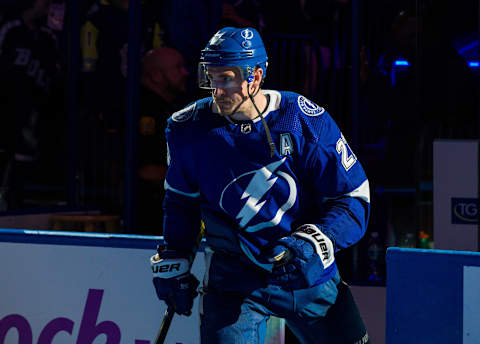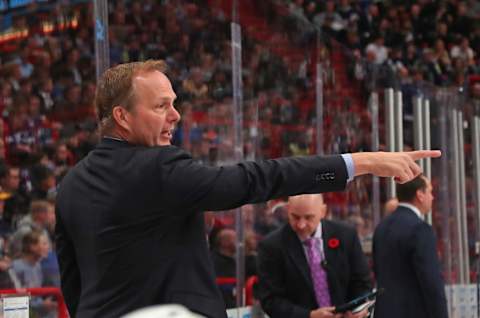Tampa Bay Lightning: Top 4 areas they need to improve in


In an earlier piece, we touched on what’s wrong with the Tampa Bay Lightning. Some readers pointed out some things that I did not include, so we’re going to address them.
As many writers do, I went on several social media platforms to promote my work. Most recently, I wrote a piece on what I believed to be four major problems that the Tampa Bay Lightning had, based on fairly thorough research and a lot of math.
As expected, comments were made by several readers, who wanted to voice their opinions. For once, it was all mostly positive comments with some other issues that people felt the Lightning had.
More from Puck Prose
- Detroit Red Wings 2023 Rookie Camp Has Plenty of Ups and Downs
- This Columbus Blue Jackets rookie doesn’t want to be forgotten
- 2 trades the Boston Bruins must make to secure the Stanley Cup
- 3 reasons the Avalanche won’t win the Stanley Cup in 2024
- This is a big year for Alex Turcotte and the Los Angeles Kings
So, I felt it would be appropriate to tackle some of my readers’ observations.
From Erik Bocca: “1. You could’ve mentioned the insane amount of road games to start the season. 2. High-grade quality chances that [Andrei] Vasilevskiy stopped last year are starting to go in – in bunches lol. But the point of high dangerous scoring chances remains the same. 3. Loss of veteran leadership, specifically on the PK [Penalty kill] – [Anton] Stralman, [Dan] Girardi, [Ryan] Callahan. 4. Still taking too many penalties…”
Well, Erik, I appreciate your support, and I will gladly look into these points you made. Let’s start with the first one: the number of away games.
Keep in mind, all these stats were gathered prior to the December 12th matchup against the Boston Bruins.
The Lightning have played 14 home and away games this season, though 1 “home” game was played in Sweden against the Sabres. It’s important to note that, at the moment, the Lightning are tied for the fewest amount of games played in the league.
It’s not about the travelling that could have an impact, however. I’m more focused on how the away games have come in bunches, which is something you also probably noticed, Erik. In their first 15 games, the Lightning had a stretch of 6 straight and 4 straight home games, while they had 5 home games split into a 1 game and 3 game stretch, with one of the 3 home games being played in Sweden.
But that’s not something that I would consider a major issue that the Lightning have dealt with. Sure, it’s a tough schedule, but every single NHL team has a tough stretch of games at one point every year. It’s tough, but it’s not something NHL teams and players can’t deal with.

The dangers Vasilevskiy faces
For your second point, you brought up the high-danger chances that Vasilevskiy has faced has remained the same as last year, but with more goals getting scored through them. This is where I can disagree. NaturalStatTrick calculates a ton of different statistics, including the amount of, what they qualify as, high-danger opportunities. Another site, CorsicaHockey, also looks at low-danger and mid-danger opportunities. But first, as mentioned, let’s look at the high-danger shots first.
Last season, Vasy faced the 16th most high-danger shots in the league with 427, with a high-danger save percentage (HDSV%) of .822%.
This season, he’s on pace for 59 starts. So far, he’s faced 161 high-danger shots, putting him on pace for roughly 475 high-danger shots. So Vasy is actually facing more high-danger shots this year, while currently holding a better HDSV% of .826%.
In that observation, you’re not exactly right. Not only is the amount of high-danger shots on pace to beat the amount he had last season, but he is also doing a better job of keeping the pucks out of the net. However, I did a little bit more research. Based on his current pace, Vasy could give up 83 goals against high-danger shots. That being said, he will technically allow more goals than last season (76), however, while facing a significant amount of shots less.
Meanwhile, according to CorsicaHockey, Vasilevskiy ranks 3rd in the league, among goalies with over 1,000 minutes of playing time, in low-danger save percentage (LDSV%), with a .988%. Vasy does struggle mightily in the mid-danger scoring opportunities area. He ranks 21st out of 24 goalies with at least 1,000 minutes in mid-danger save percentage (MDSV%), with a .875%. Unfortunately, Corsica does not calculate the amount of low or mid-danger shots a goalie faces, but that MDSV% is really poor.
Last season, Vasy had a .979 LDSV%, which ranked 9th among goalies with at least 2,000 minutes of ice time. He also had a .929 MDSV%, which ranked 4th in the league among those same qualified goalies. So while you’re not entirely right about Vasilevskiy giving up more high-danger shots, it is true that he is struggling when facing shots deemed somewhere between a bad scoring chance and a great one. He needs to improve in that area, especially since we all know he can play much better.

Issues with the penalty kill
For your third point, you talked about the loss of leadership on the penalty kill. Not only just the loss of leadership, however, but more specifically the loss of Anton Stralman, Ryan Callahan, and Dan Girardi. I absolutely agree that the PK could be better, it isn’t because of the loss of leadership, so I disagree once more with one of your points.
Thanks, again, to NaturalStatTrick for providing me with total PK time on ice for individual players. Without that, I wouldn’t be able to share with all of you the leaders in PK ice time among forwards from this season and last season.
Last season, Anthony Cirelli led the charge with an astounding 222:31 time on ice on the PK. Following him is Cedric Paquette (161:22), Alex Killorn (159:34), Yanni Gourde (139:52), Callahan (53:01), Steven Stamkos (49:19), Mathieu Joseph (47:46), Tyler Johnson (37:13), Adam Erne (19:34), Ondrej Palat (8:43), JT Miller (3:55), Nikita Kucherov (3:25), and Danick Martel (1:22).
The top-4 leading penalty killers for the Lightning are still on the roster. It’s important to know who the top-4 penalty-killing forwards are because, usually, team’s kill using 2 forwards and 2 defensemen on their two PK units. Thus, the top-4 forwards paints a picture as to who the regular penalty killers are.
As for defensemen, the ranking goes as follows: Ryan McDonagh (257:46), Victor Hedman (148:45), Girardi (140:12), Erik Cernak (140:09), Stralman (136:25), Braydon Coburn (75:55), Mikhail Sergachev (16:28), and Cameron Gaunce (2:13).
Girardi was the third-most used penalty-killing blueliner, but it’s important to note that Cernak, who ranked right behind him, was a mid-season addition via a call-up from AHL-affiliate Syracuse and very well could have eaten more time off of Girardi’s plate. Meanwhile, Stralman played fewer games than Cernak and still ranked favorably, so take that as you want. The fact of the matter is, of the three players that were directly mentioned, just one was considered a regular on one of the two PK units. Based on the ice-time, here’s what those units looked like last season:
Cirelli-Paquette
McDonagh-Hedman
Killorn-Gourde
Girardi-Cernak
This ultimately means that, this season, the Lightning needed to replace Girardi on the second PK unit this season, while also adding extra PKers to replace the additional minutes that both Callahan and Stralman made up.
Here’s what the PK ice time looks like this season for forwards: Cirelli (86:40), Killorn (67:43), Paquette (42:07), Palat (38:43), Gourde (29:13), Joseph (26:52), Stamkos (16:46), Johnson (5:36), Brayden Point (3:24), Gemel Smith (1:52), Carter Verhaeghe (1:39), Kucherov (1:10), Luke Witkowski (1:07), and Pat Maroon (0:46).
Palat rose above Gourde to become a regular on the PK for this season. Now, I personally don’t know how to feel about that shift, but, Palat has been much better this season than last, so the boost in ice time in all situations is deserving. Joseph has also received a boost in PK ice time this season, which helps lessen the blow of losing Callahan. However, Joseph is still young, and far less experienced than Callahan. That being said, I wouldn’t say a simple increase in ice time would help. Yet, here we are. I feel as though the Lightning are hugely under-utilizing Maroon, and he could be a nice bit of help on the PK, especially considering his experience over Joseph in the NHL. Fortunately for all Lightning fans, I’m not the one calling the shots, but I can say that it might be a decent idea to give Maroon some more time here.
As for defensemen, the list goes as follows: McDonagh (106:15), Cernak (82:16), Hedman (43:04), Luke Schenn (24:36), Kevin Shattenkirk (17:52), Jan Rutta (17:13), Coburn (16:28), and Sergachev (10:25).
Schenn is a big surprise to me here, as he comes in as the fourth-most utilized defenseman on the PK, despite playing just a handful of games. Perhaps another surprise, Shattenkirk is right there behind him, however, he is more of a regular in the NHL lineup, so he gets the nod, by me, as the #4 PK defenseman. One thing I would like to see is Coburn or Sergachev get more time, though Sergachev is more offensively-minded and is already on pace for more PK minutes this season than last. Based on ice time, here’s what the two PK units look like:
Cirelli-Killorn
McDonagh-Cernak
Paquette-Palat
Hedman-Shattenkirk
Those are two solid units, yet they still struggle. Again, a way to help the PK a bit more is to add some of the bigger and more experienced guys into the mix, such as Maroon and Coburn, as I previously stated. As a whole, however, the Lightning did not actually lose that much in terms of PK specialists, therefore you’re not entirely correct with the guys you directly mentioned.

Lack of discipline
For your final point, you brought up how the Lightning are too undisciplined and take too many penalties. Just as a reminder, every stat I have used to this point does not include the December 12th game against the Boston Bruins.
The Lightning have been short-handed 95 times this season, which is an average of 3.4 penalties a game. The league average is 96 penalties, which means that the Lightning are actually below average when taking penalties. However, and this is important to keep in mind, the Lightning have also played fewer games than the average NHL team, which is 30-31 games played.
That being said, their 3.4 penalties per game is higher than the league average of 3.2. However, it’s a tiny difference and ultimately shows that, when it comes to taking penalties, the Lightning are just average. So, ultimately, I’m going to have to disagree again. However, it goes much deeper than just the volume of penalties taken.
The most important times to play disciplined and mistake-free hockey is when you are in a tied game or up by one because a single goal can completely flip the momentum in your opponents favor. Unfortunately for the Lightning, of their 95 penalties, 58.9% of them came while leading by a goal or when the game is tied.
Another 16.8% of their penalties came while winning by 2 or more goals. That’s completely unacceptable for any team. When the Lightning are losing by 2 or more goals, they tend to stay relatively disciplined, with only 7.4% of their penalties coming in that situation. Meanwhile, when they are losing by just 1 goal, they tend to rack up quite a few penalties, with 16.8% of their penalties coming in that situation.
The Lightning haven’t been completely undisciplined this season as a whole. However, the problem is that they take penalties in the worst situations a majority of the time. It doesn’t help that the Lightning have been below-average killing penalties off either, which puts an exclamation point on the need to be better disciplined in those important situations.
Next. NHL Power Rankings. dark
I hope you guys enjoyed an additional 4 points! If you have any questions that you want to be featured on a future article, shoot me a message through Facebook (look at the byline for my name) or Twitter (my twitter handle is @Pereira_Report). Thanks for reading!